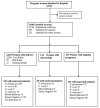Adverse pregnancy outcomes in an area where multidrug-resistant plasmodium vivax and Plasmodium falciparum infections are endemic
- PMID: 18419439
- PMCID: PMC2875100
- DOI: 10.1086/586743
Adverse pregnancy outcomes in an area where multidrug-resistant plasmodium vivax and Plasmodium falciparum infections are endemic
Abstract
Background: Plasmodium falciparum infection exerts a considerable burden on pregnant women, but less is known about the adverse consequences of Plasmodium vivax infection.
Methods: In Papua, Indonesia, where multiple drug resistance to both species has emerged, we conducted a cross-sectional hospital-based study to quantify the risks and consequences of maternal malaria.
Results: From April 2004 through December 2006, 3046 pregnant women were enrolled in the study. The prevalence of parasitemia at delivery was 16.8% (432 of 2570 women had infections), with 152 (35.2%) of these 432 infections being associated with fever. The majority of infections were attributable to P. falciparum (250 [57.9%]); 146 (33.8%) of the infections were attributable to P. vivax, and 36 (8.3%) were coinfections with both species. At delivery, P. falciparum infection was associated with severe anemia (hemoglobin concentration, <7 g/dL; odds ratio [OR], 2.8; 95% confidence interval [95% CI], 2.0-4.0) and a 192 g (95% CI, 119-265) reduction in mean birth weight (P<.001). P. vivax infection was associated with an increased risk of moderate anemia (hemoglobin concentration, 7-11 g/dL; OR, 1.8; 95% CI, 1.2-2.9; P=.01) and a 108 g (95% CI, 17.5-199) reduction in mean birth weight (P<.019). Parasitemia was associated with preterm delivery (OR, 1.5; 95% CI, 1.1-2.0; P=.02) and stillbirth (OR, 2.3; 95% CI, 1.3-4.1; P=.007) but was not associated with these outcomes after controlling for the presence of fever and severe anemia, suggesting that malaria increases the risk of preterm delivery and stillbirth through fever and contribution to severe anemia rather than through parasitemia per se.
Conclusions: These observations highlight the need for novel, safe, and effective treatment and prevention strategies against both multidrug-resistant P. falciparum and multidrug-resistant P. vivax infections in pregnant women in areas of mixed endemicity.
Figures
Comment in
-
Plasmodium vivax infection during pregnancy: an important problem in need of new solutions.Clin Infect Dis. 2008 May 1;46(9):1382-4. doi: 10.1086/586744. Clin Infect Dis. 2008. PMID: 18419440 No abstract available.
References
-
- Wickramasuriya GAW. Clinical features of malaria in pregnancy: malaria and ankylostomiasis in the pregnant women. Oxford University Press; London: 1937.
-
- Menon R. Pregnancy and malaria. Med J Malaya. 1972;27:115–9. - PubMed
-
- McGregor IA. Epidemiology, malaria and pregnancy. Am J Trop Med Hyg. 1984;33:517–25. - PubMed
-
- van Geertruyden JP, Thomas F, Erhart A, D'Alessandro U. The contribution of malaria in pregnancy to perinatal mortality. Am J Trop Med Hyg. 2004;71:35–40. - PubMed
-
- Nosten F, ter Kuile F, Maelankirri L, Decludt B, White NJ. Malaria during pregnancy in an area of unstable endemicity. Trans R Soc Trop Med Hyg. 1991;85:424–9. - PubMed
Publication types
MeSH terms
Substances
Grants and funding
LinkOut - more resources
Full Text Sources
Other Literature Sources
Miscellaneous


